Fascinating Facts About Nalanda Gedige

If you’re planning a trip to Sri Lanka, you’re likely already excited about exploring its stunning beaches, lush tea plantations, and majestic ancient cities. But nestled quietly in the Matale District lies a lesser-known treasure that offers a unique glimpse into the island’s rich cultural tapestry: Nalanda Gedige. Whether you’re a history enthusiast, a curious traveler, or someone seeking a peaceful retreat, Nalanda Gedige promises an unforgettable experience. Let’s dive into the fascinating world of this ancient marvel, uncovering its history, myths, and the intriguing journey it has undertaken over the centuries.
Origins of the Nalanda Gedige
Nalanda Gedige is not your typical tourist spot. This small yet captivating archaeological site dates back to the 8th to 10th centuries AD, making it a significant relic from Sri Lanka’s Anuradhapura Kingdom era. What sets Nalanda Gedige apart is its unique blend of Buddhist and Hindu architectural styles, reflecting the multicultural and religious harmony that characterized Sri Lanka during its peak.
Originally constructed as a Hindu temple, Nalanda Gedige showcases intricate stone carvings and structural elements typical of South Indian Dravidian architecture. Over time, as Buddhism flourished in Sri Lanka, the temple was repurposed into a Buddhist shrine, a common practice in the region that highlights the seamless coexistence of these two major religions. This architectural fusion not only underscores the island’s diverse cultural influences but also serves as a testament to the adaptability and resilience of its people.
What Nalanda Gedige means and represents?
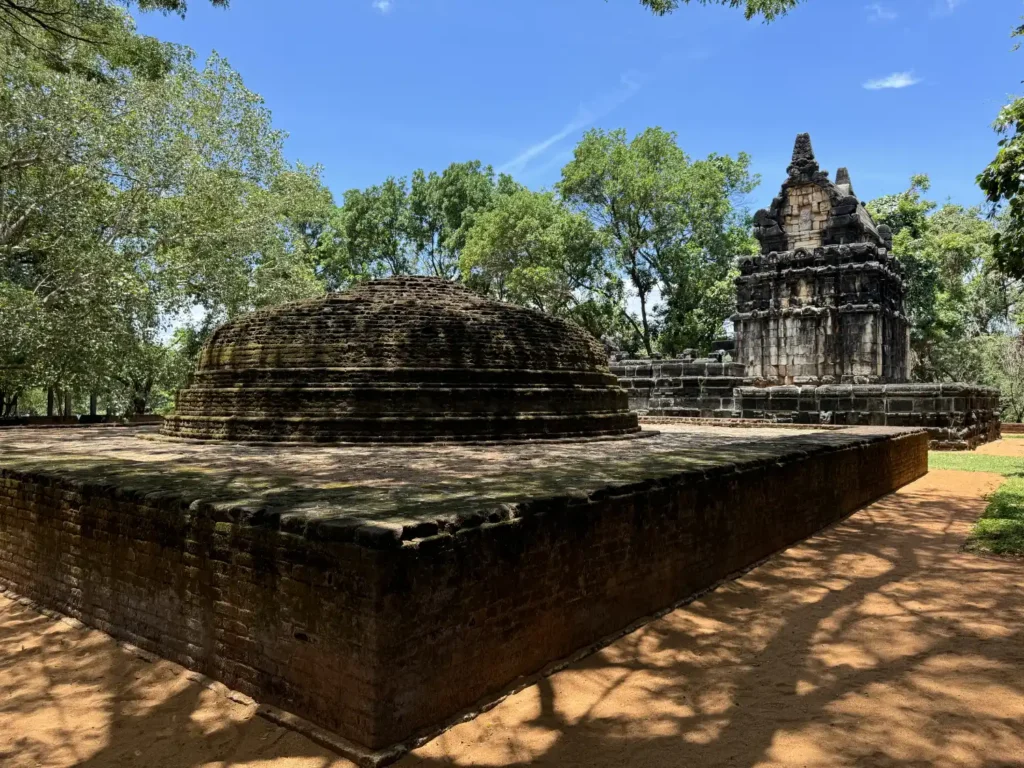
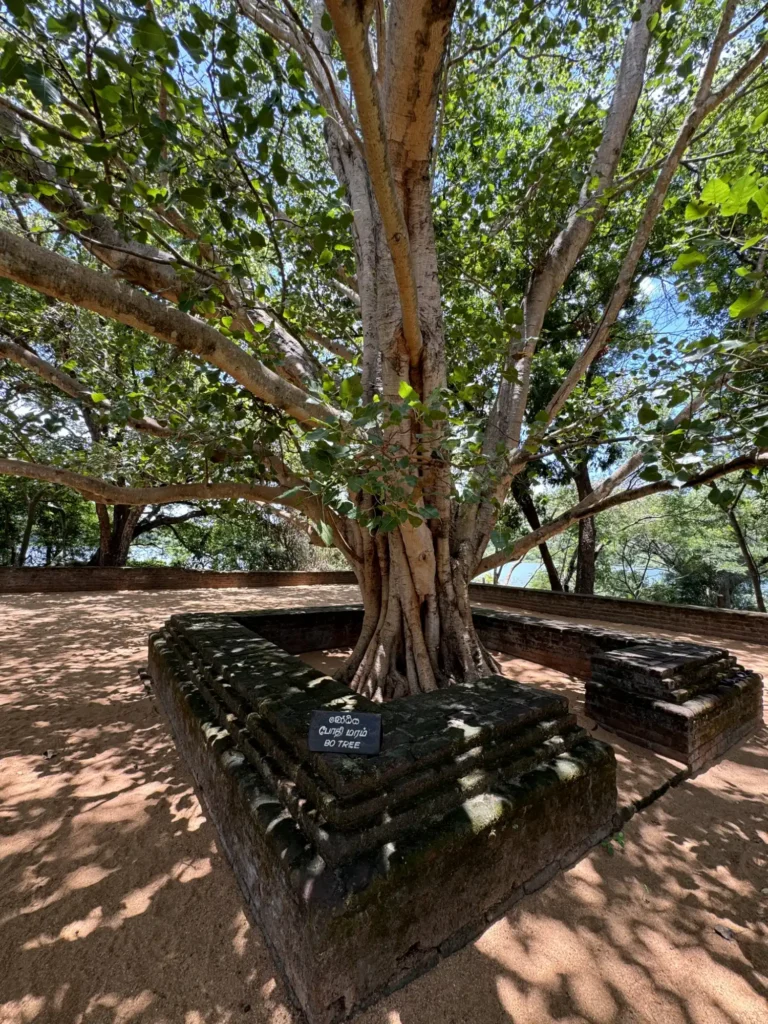
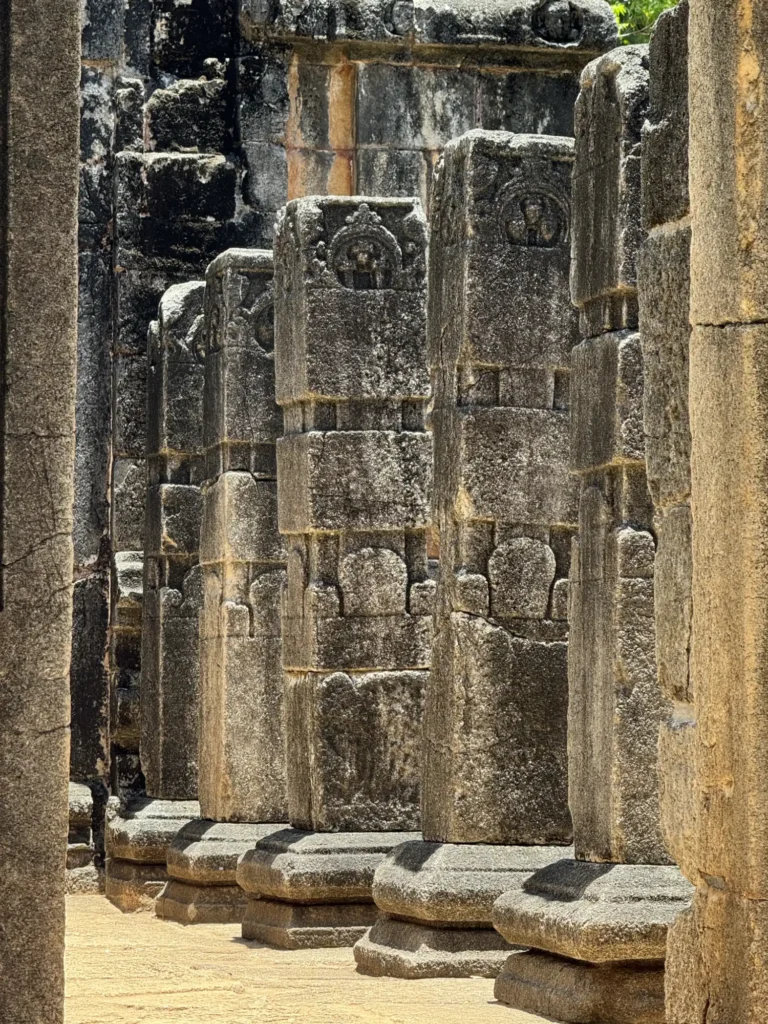
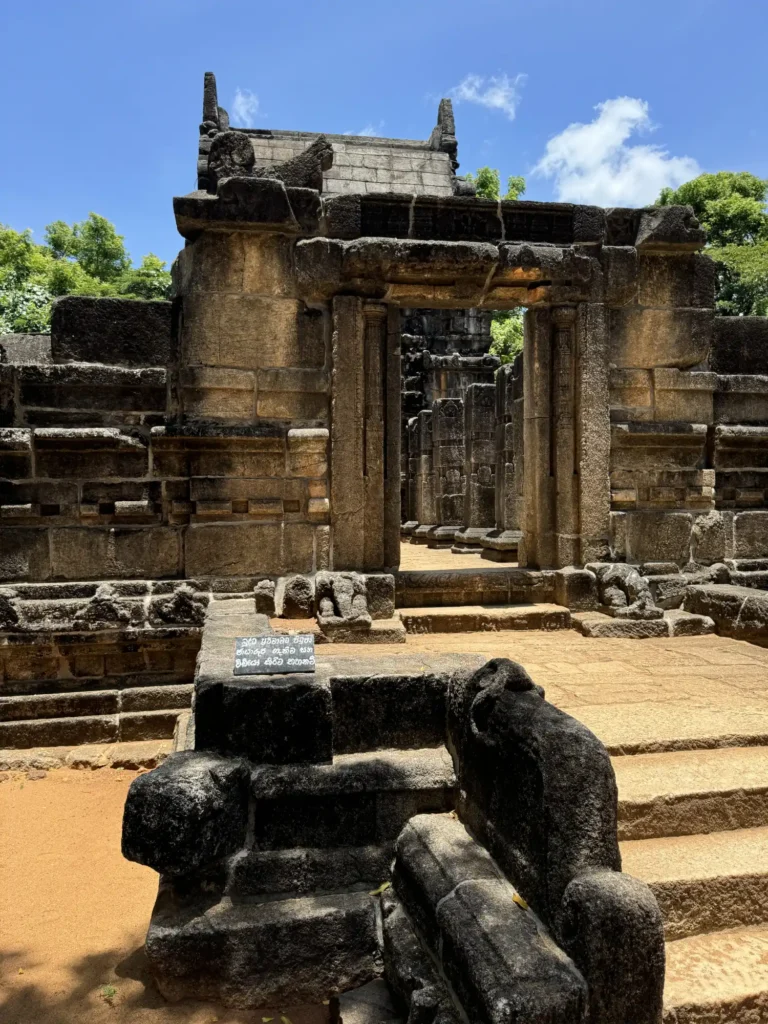
Nalanda Gedige stands as a remarkable example of cultural syncretism, where different religious and cultural traditions merge to create something uniquely beautiful. The temple’s design incorporates elements from both Hinduism and Buddhism, making it a living symbol of religious harmony. The presence of a stupa—a dome-shaped structure used as a Buddhist shrine—within a predominantly Hindu architectural framework, exemplifies this blend.
This fusion is further evident in the temple’s decorative motifs. You’ll find depictions of Hindu deities alongside Buddhist symbols, illustrating how the site served as a spiritual hub for people of diverse beliefs. Such architectural hybridity is rare and makes Nalanda Gedige a significant point of interest for those keen on understanding the intricate interplay between different cultural and religious influences in Sri Lanka’s history.
Myths about Nalanda gedige
Myth 1: The Sacred Serpent of Nalanda Gedige
One of the most enchanting legends surrounding Nalanda Gedige is that of the sacred serpent. According to local folklore, a mystical serpent once roamed the area where the temple now stands. This serpent was believed to possess divine powers and was revered by the local villagers. It is said that those who visited the temple and offered prayers to the serpent would have their wishes granted and receive blessings of protection and prosperity.
This legend not only emphasizes the temple’s spiritual significance but also highlights the deep connection between the local community and their natural surroundings. The sacred serpent symbolizes protection and benevolence, reinforcing the temple’s role as a place of sanctuary and divine intervention.
Myth 2: The Hidden Treasure Beneath Nalanda Gedige
Another captivating myth is the tale of a hidden treasure buried beneath Nalanda Gedige. According to the story, a wealthy merchant who frequented the temple decided to safeguard his riches by hiding them within the temple grounds. To protect his treasure from invaders and thieves, he enlisted the help of spiritual guardians—mystical beings believed to be the temple’s protectors.
Despite numerous attempts by treasure hunters and adventurers to locate the hidden riches, the treasure remains elusive to this day. This legend adds an element of mystery and allure to Nalanda Gedige, enticing curious travelers to explore its grounds in hopes of uncovering secrets long concealed by time.
Myth 3: The Guardian Spirits of Nalanda Gedige
Local folklore also speaks of guardian spirits that watch over Nalanda Gedige. These spirits are believed to be the souls of ancient monks and devotees who dedicated their lives to the temple. They are said to protect the site from harm and ensure that its sanctity is preserved. Visitors often report feeling a sense of calm and serenity, attributing these feelings to the presence of these benevolent spirits.
These stories not only enrich the visitor experience but also underscore the temple’s enduring spiritual significance, making Nalanda Gedige a place where history, legend, and spirituality converge.
The Original Nalanda Gedige: A Journey Through Time
Nalanda Gedige’s history is marked by its relocation, a testament to the enduring value placed on preserving cultural heritage. Originally situated near a picturesque lake in Matale, the temple faced a significant threat in the 1970s with the construction of the Bowatenna Reservoir. This development risked submerging the original site underwater, prompting urgent measures to save this architectural gem.
The Sri Lankan government, recognizing the temple’s historical and cultural importance, embarked on an ambitious project to relocate Nalanda Gedige. This involved meticulously dismantling the temple, stone by stone, numbering each piece to ensure accurate reconstruction. The relocation process was a collaborative effort, involving local artisans, archaeologists, and engineers who worked tirelessly to preserve the temple’s integrity.
Nalanda Gedige: The Relocation


Moving Nalanda Gedige was no small feat. The relocation process required precision and care to maintain the temple’s original design and structural stability. Each stone was carefully cataloged, transported, and reassembled at a new location approximately 2 kilometers away from its original site. This new location, perched on a hilltop, offers stunning views of the surrounding landscape, enhancing the temple’s serene and contemplative atmosphere.
The relocation not only saved Nalanda Gedige from being submerged but also provided it with a more accessible and prominent position. Today, the temple stands as a beacon of Sri Lanka’s rich heritage, attracting visitors who marvel at its architectural beauty and historical significance. The successful relocation of Nalanda Gedige is a proud example of Sri Lanka’s commitment to preserving its cultural landmarks for future generations.
Nalanda Gedige: Location
Today, Nalanda Gedige is nestled on a hilltop in the Matale District, surrounded by lush greenery and offering panoramic views of the central highlands. This new setting enhances the temple’s tranquil ambiance, making it an ideal spot for reflection and meditation. The hilltop location also makes the temple more accessible to visitors, allowing them to fully appreciate its architectural splendor and the natural beauty that surrounds it.
Visitors to the current site can explore the intricately carved stone structures, marvel at the fusion of Hindu and Buddhist elements, and soak in the peaceful environment that Nalanda Gedige now enjoys. The relocation has not only preserved the temple but has also elevated its status as a must-visit destination for those exploring the heart of Sri Lanka.
Nalanda Gedige: The Symbolic Center of Sri Lanka


Nalanda Gedige is often hailed as the “geographical center” of Sri Lanka, a title that adds to its allure and significance. This designation is based on historical surveys conducted in the early 20th century, which identified the area around Matale as the central point of the island. While modern geographical tools like GPS may offer more precise calculations, the symbolic importance of Nalanda Gedige as the center remains undiminished.
The temple’s central location underscores its historical role as a spiritual and cultural hub. It was strategically placed to be accessible to people from different regions, facilitating the exchange of ideas, beliefs, and artistic expressions. Today, this centrality enhances Nalanda Gedige’s appeal, positioning it as a focal point where history, culture, and spirituality converge.
Early writings about Nalanda gedige

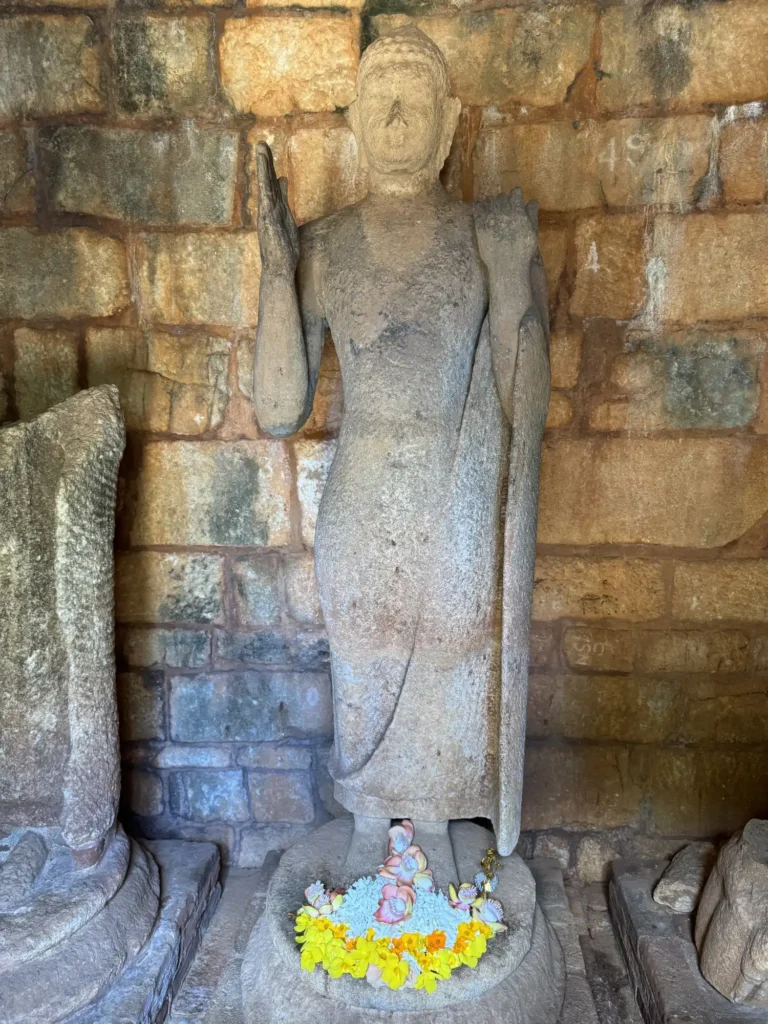
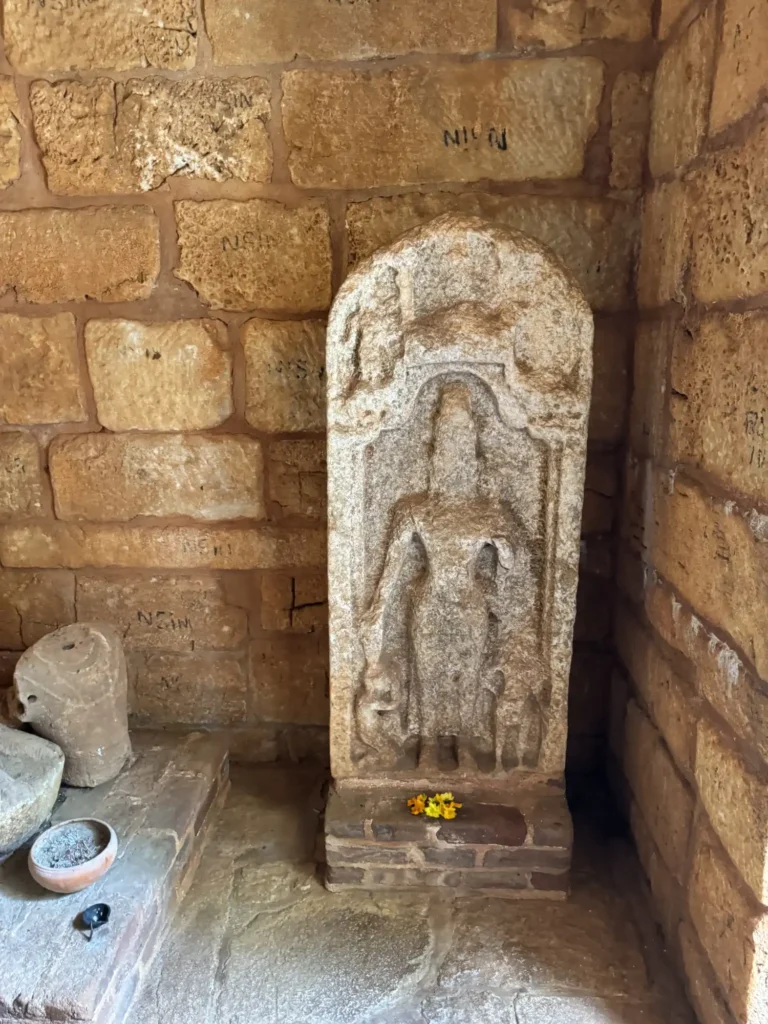

Nalanda Gedige has attracted the attention of scholars and writers long before the 20th century. One of the earliest references to the site can be found in the works of Robert Knox, a British sea captain who was held captive in Sri Lanka during the 17th century. In his book, An Historical Relation of the Island Ceylon, Knox mentions a temple in the central highlands that aligns with the description of Nalanda Gedige.
Another significant mention comes from James Emerson Tennent, a British civil servant in colonial Ceylon. In his comprehensive work, Ceylon: An Account of the Island Physical, Historical, and Topographical, Tennent provides detailed observations about Sri Lanka’s ancient sites, including Nalanda Gedige. His writings offer valuable insights into how early European visitors perceived and documented the temple’s unique architecture and cultural significance.
These early accounts not only highlight Nalanda Gedige’s historical importance but also provide a foundation for contemporary studies and tourism promotion. They serve as a bridge connecting the past with the present, allowing visitors to appreciate the temple’s enduring legacy.
Interesting and Lesser-Known Facts About Nalanda Gedige
While Nalanda Gedige is renowned for its architectural beauty and historical significance, there are several lesser-known facts that make it even more fascinating:
- Architectural Anomaly: Facing West Unlike most Buddhist structures that traditionally face east, Nalanda Gedige is oriented towards the west. This unusual alignment has intrigued historians and architects alike, prompting various theories about its significance and the influences that shaped its design.
- The Missing Roof Mystery One of the most striking features of Nalanda Gedige is its absence of a roof. Scholars debate whether the temple was intentionally left unfinished or if the roof, originally made of wood, deteriorated over time. This missing element adds an air of mystery and invites visitors to imagine how the temple might have looked in its complete form.
- Astronomical Alignments Some researchers believe that Nalanda Gedige may have been used as an astronomical observatory. The temple’s alignment with certain celestial bodies suggests that it might have played a role in tracking the movements of stars and planets, integrating scientific observation with spiritual practice
- Symbolic Guardian Stones At the entrance of Nalanda Gedige, visitors can find a pair of intricately carved guardian stones. These stones are believed to protect the temple from evil spirits and ensure the safety of those who enter. The craftsmanship and symbolic significance of these stones highlight the temple’s spiritual protective functions.
- A Place of Meditation and Retreat Despite its small size, Nalanda Gedige was likely a significant site for meditation and spiritual retreat. Its secluded location and serene surroundings provide an ideal environment for introspection and spiritual practice, continuing to attract those seeking peace and enlightenment.
Visiting the Nalanda Gedige
Visiting Nalanda Gedige is like stepping into a time capsule, where history and spirituality intertwine seamlessly. Here’s what you need to know to make the most of your visit:
Nalanda Gedige is located in the Matale District, approximately 20 kilometers north of Dambulla. The easiest way to reach the temple is by car or tuk-tuk, with the journey from Dambulla taking about 30 minutes. The hilltop location means you might encounter a short hike, but the effort is well worth the breathtaking views and the tranquil ambiance that awaits you.
Best time to Visit the Nalanda Gedige
Sri Lanka enjoys a tropical climate, making it a year-round destination. However, the best time to visit Nalanda Gedige is during the cooler months from November to April, when the weather is pleasant and ideal for exploring outdoor sites. Early mornings or late afternoons are particularly enjoyable, offering cooler temperatures and the soft glow of the rising or setting sun enhancing the temple’s beauty.
When visiting Nalanda Gedige, it’s advisable to wear comfortable clothing and sturdy footwear, especially if you plan to explore the surrounding areas. Don’t forget your camera to capture the intricate carvings and stunning vistas. Additionally, bringing a hat, sunglasses, and sunscreen will help protect you from the tropical sun.
As a place of historical and spiritual significance, it’s important to respect Nalanda Gedige during your visit. Dress modestly, remove your shoes before entering the temple areas, and maintain a quiet demeanor to preserve the serene atmosphere. Photography is generally allowed, but it’s best to ask for permission if you wish to take close-up shots of carvings or any artifacts.
Nalanda Gedige – Sri Lanka’s Center Point and Mysterious Place to visit
Nalanda Gedige is more than just an ancient temple; it’s a window into Sri Lanka’s multifaceted history and a testament to the island’s enduring cultural harmony. Its unique architectural style, rich historical significance, and the captivating myths that surround it make Nalanda Gedige a hidden gem waiting to be discovered.
As you plan your visit, take the time to immerse yourself in the stories and legends that breathe life into this remarkable site. Whether you’re marveling at the intricate carvings, exploring the temple’s peaceful surroundings, or simply soaking in the panoramic views, Nalanda Gedige promises an enriching and memorable experience.
So, the next time you find yourself wandering through Sri Lanka’s enchanting landscapes, make sure to carve out some time to explore Nalanda Gedige in Matale. It’s a journey that will not only deepen your appreciation for Sri Lanka’s rich heritage but also leave you with stories and memories to cherish for years to come.
References on the Post:
Knox, Robert. An Historical Relation of the Island Ceylon. 1681.
Tennent, James Emerson. Ceylon: An Account of the Island Physical, Historical, and Topographical. 1860.
Wickremasinghe, D. M. de Z. Folktales of Sri Lanka. Government Press, 1953.
Seligmann, C. G., & Seligmann, Brenda Z. Folk Tales of the Low Country of Ceylon. Ceylon Times, 1893.
Parker, Henry. Sinhala and Tamil Folk-Tales from Ceylon. 1896.
Department of Archaeology, Sri Lanka. Official Records on the Relocation of Nalanda Gedige.
University of Peradeniya. Archaeological Publications on Nalanda Gedige’s Architectural Significance.
